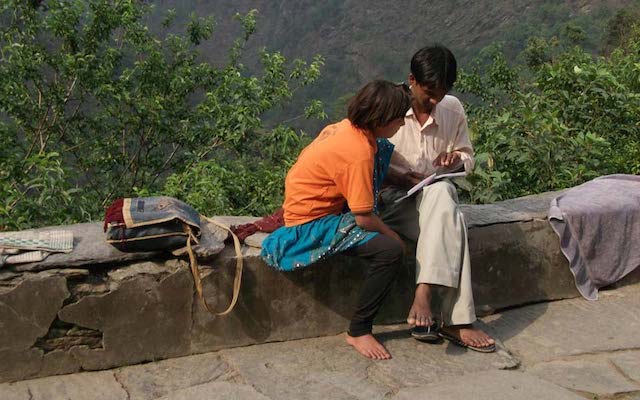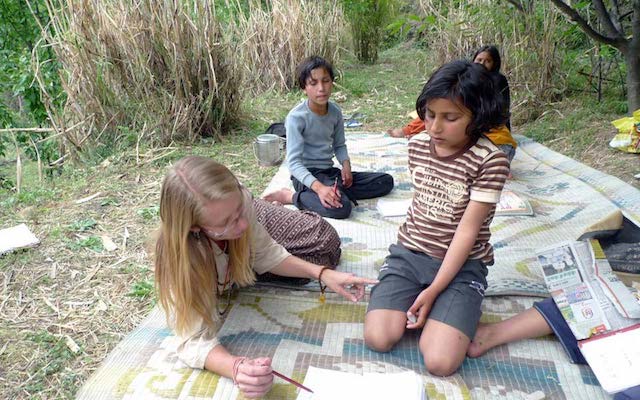
“Who checks your diary?” 13-year-old Shradha asked me, looking over my shoulder.
Out of habit, I tried to hide what I was writing, as if she could actually read and understand my scribbled English handwriting.
Among the many lessons I’ve learned from this rural Himalayan girl’s perspective on life, this simple question began an unraveling of self that has continued to impact me—especially now, as I begin this new chapter: daring to write for an audience.
Shradha was one of my many wise, young housemates among the multi-generational group of co-learners living together at Space for Nurturing Creativity, a residential learning center in the Kedarnath Valley of Uttarakhand, India.
A mere fragment of our quite extensive holistic curriculum, one ideal for those living at center was being your true, authentic self no matter what, sharing that authenticity with others, and thus cultivating the vulnerability necessary to tear down our self-defeating, yet ostensibly protective walls that otherwise prevent us from doing just that.
It was an instillation process that proved to be both one of the most difficult times and crucial endeavours in all of my 80 months living in North India.
At some points, I grew quite overwhelmed discovering how much I had to face about myself, living as the only foreigner among 25 Indians aged 6 to 37 (my age at that time), in what I still call the “House of Mirrors.”
In our collaborative, mindful home-school, the main teaching was: “Apne aap ko dekho, apne aap ko suno, apne aap ko samajh lo,” which translates to “Look at yourself, listen to yourself, understand yourself.” This free fall into the depths of our own shadowy oceans was a feat supported by a daily sadhana that combined hours of meditation with journaling and sharing our discoveries with fellow housemates through dialog and diary checks.
Aside from the initial language barrier, as an American conditioned to be super self-sufficient and independent, I had my share of struggles in collaboration. Then, adding to my recipe for disaster (in fitting in), I was also extremely private. So you can imagine that, considering my nervousness about someone reading over my shoulder as I spilled out my inner-most secrets in blue ink into my personal notebook, the idea of someone checking my diary sound absolutely terrifying.
So, I persisted. And over the year following that conversation with Shradha, my habit of writing as my main mode of expression contributed to the slow construction of a barrier between the group and myself. Not only because what I wrote was in English, but more importantly, I had not been even attempting to translate and share what I wrote.
I started to notice their diaries were not kept hidden under pillows, or tucked away in a dresser drawer under their t-shirt pile, or behind a secret pocket in a jholi (embroidered hand bag) like mine was. Their diaries were haphazardly left just about anywhere, almost waving their pages, asking to be picked up and read by any curious housemate.
I observed the girls sitting under trees swapping notebooks, bonding over reading passages to each other and sharing their secrets, which instantly ceased to be secrets. And as I saw this protective wall around me being constructed, a boundary I had not noticed around any one else in this collective, I began to feel left out. I filled my personal pages with a depressing sense of drowning, each thought put into form, which only re-manifested my utter loneliness, all the while foolishly clutching my notebook even tighter.
That conversation and the situation that inspired it (years ago, in fact) still lingers in me and began to surface more seriously this past September, when I found an old trunk full of personal journals, kept since I was old enough to hold a pencil somewhat correctly.
So I had to ask myself: from where did the habit start—to hold in my ideas and emotions, to hold back from speaking out, to hide my inner-most expressions or to hold back my tears?
Where did this sense of privacy come from? How did I get into the habit of filling notebooks with all the thoughts I was afraid to share with others? What is going on in my head that is so personal, I need to hide? What am I really afraid of? Rejection?
I’m still uncovering the answers to those questions as I carefully untangle all the knots that have kept me closed up inside. Because until recently, my writing has usually been just for me—to clear away the luggage I would otherwise exhaust myself attempting to carry.

The past two weeks, having set the intention to dare myself, I have put down the pen, left my notebook tucked away, and began making 10-finger syncopations on my keyboard.
Surprisingly, I find an unfamiliar relief in feeling safe to share and allow someone else to hear my heart—the dialogues in my head that otherwise fell quietly in line among the rest, kept locked up in that unchecked trunk of diaries.
And with this new practice of writing for an audience, I am beginning to recognize the inherent need in all of us to be truly heard. I witness the opening of my heart, directly related to the crumbling of my protective walls—so carefully constructed over decades of collecting and holding on to little grains of hurt, which were never swept away. And I realize this vulnerability, however initially scary, is an even more crucial ingredient to my spiritual growth and progress on this path of sadhana.
Sharing this piece of writing with you all now is the first swing of the sledgehammer, initiating a long overdue crumble.
~
Author: Nicole Jaquis
Images: Author’s Own
Editor: Catherine Monkman








Read 0 comments and reply